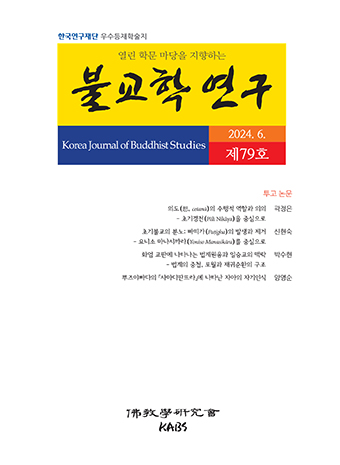특집논문
Abstract
References
Information
In Kamakura period, Japanese Huayan school consisted of two streams: Todaiji Temple and Kozanji Temple. Kishinron-Honsho-Choshuki (heareafter KHC), written by Junko(順高),is the oldest commentary on the Dashengqixinlunyiji. Junko is situated in the flow of Myoe(明恵)’s thought, the founder of the Kozanji stream.
Only 28 volumes of KHC have survived now among 29 volumes in total. In KHC, Biziaoji(筆削記), by Zixuan(子璿) of the Song Dynasty, is cited most, followed by a book of Junko’s teacher Kikai(喜海) that was quoted in about 700 places. In addition, Junko has actively expressed his own opinions by the expression “I think”. Furthermore, other commentaries on Qixinlun, such as those of Huiyuan, Wonhyo, and Zongmi are quoted from 75 times to 85 times respectively. Moreover, eight other Qixinlun commentaries are also cited, including missing texts such as Suishiji(隨疏記) of Chuanao(傳奧) from Wonjong-munryu written by Uicheon in Goryeo period.
KHC specially quotes Wonhyo’s biography from Gangyojisho(元暁事抄) and Huijieji(會解記). This shows that Junko highly appreciated Wonhyo whom he regarded as a monk of Huayan school. KHC agrees with Wonhyo only when Wonhyo’s commentary corresponds with those of Fazang or Zongmi. There is one case where Wonhyo’s commentary is criticized when his views differ from Fazang’s. Considering these facts, even though KHC highly estimated the biographical facts of Wonhyo, he was used secondarily at most in aspects of thoughts or citation rate.
가마쿠라시대 일본 화엄종은 동대사(東大寺)와 고산사(高山寺)의 두 흐름을 형성한다. 이 가운데 고산사계의 창시자인 묘에(明恵)의 흐름을 잇는 준코(順高)가 저술한 『기신론본소청집기(起信論本疏聴集記)』는 법장 『大乗起信論義記』에 대한 현존 최고(最古) 주석서이다. 본서는 전 29권 가운데 현재 28권이 남아있다. 준코는 『청집기』에서 송대 자선(子璿)의 『필삭기(筆削記)』를 가장 많이 의용하며, 그의 스승인 기카이(喜海)의 인용도 700회정도로 그 다음을 잇는다. 또한 사운(私云)으로 자설도 300회 정도 적극적으로 표현하고 있다. 한편, 『필삭기』 이외의 『기신론』 관련문헌으로써 혜원, 원효, 종밀의 『기신론소』가 75회에서 85회 정도 인용되어 있다. 그 외에도 고려 의천의 『원종문류』로부터 전오(傳奧)의 『수소기(隨疏記』 등의 일실문헌을 비롯해 8종류의 『기신론』 문헌이 인용되어 있다. 이 가운데 『원효소』의 인용은 해석분(54회)에 집중되지만, 현담으로부터 인연분까지 27회정도 인용되며, 이 부분에서 중요한 인용 패턴을 충분히 고찰할 수 있다.
『청집기』에서는 『원효사초(元暁事抄)』,『회해기(회解記)』로부터 원효의 전기를 특필한다. 이를 통해 인물 원효를 높이 평가함을 알 수 있다. 또는 원효를 화엄종의 인물로 보면서 대체로 원효의 견해를 따르지만, 원효의 견해가 종밀이나 법장과 같을 때만 인정되는 경향성도 있다. 한 번 비판을 받는 부분은 법장과 의견을 달리하는 부분이다. 이러한 점으로 보아 원효의 전기가 중요시되면서도 인용빈도수나 사상적으로는 2차적이었음을 알 수 있다.
-
원전자료
- 法蔵 『大乗起信論義記』 (『大正藏』 44)
- 元暁 『起信論疏』 (『大正藏』 44)
- 順高 『起信論本疏聴集記』 (『日仏全』 92) 단행본류
- 福士慈稔, 日本仏教各宗の新羅・高麗・李朝仏教認識に関する研究第3巻-日本華厳宗 にみられる海東仏教認識-、身延山大学、2012.
- 望月信亨, 大乗起信論之研究、金尾文淵堂、1922. 논문류
- 金天鶴, 「元暁 起信論記・疏의 전승조사와 정본화 시도」 「書誌學研究」 73, 韓國書誌學會, 2018. pp.157-178.
- 武覚超, 「順高の起信論本疏聴集記」 について「ー高山寺学派の実践形態ー」 天台学報 14、1971, pp.197-201.
- 朴鎔辰, 「高麗義天撰 円宗文類の日本伝承と交流史的意義」 印度學佛教學研究 63‐1, 2014, pp.39-42.
- Publisher :Korean Association of Buddhist Studies
- Publisher(Ko) :불교학연구회
- Journal Title :Korea Journal of Buddhist Studies
- Journal Title(Ko) :불교학연구
- Volume : 57
- No :0
- Pages :1-21


 Korea Journal of Buddhist Studies
Korea Journal of Buddhist Studies






